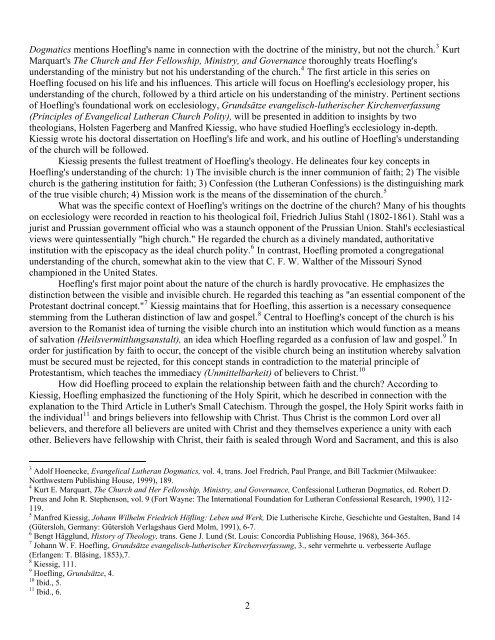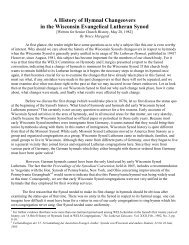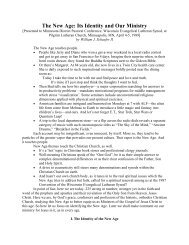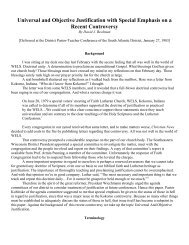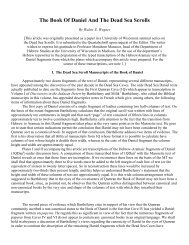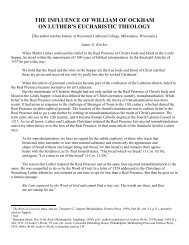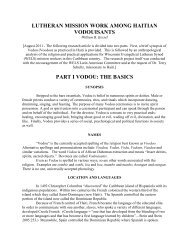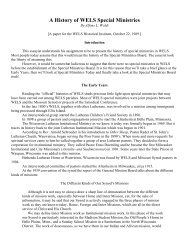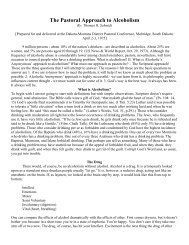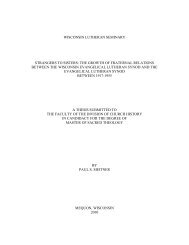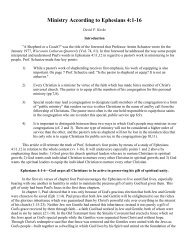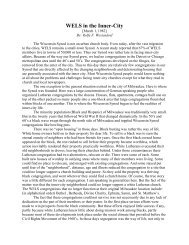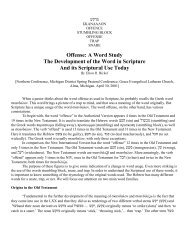Johann Wilhelm Friedrich Hoefling - Wisconsin Lutheran Seminary ...
Johann Wilhelm Friedrich Hoefling - Wisconsin Lutheran Seminary ...
Johann Wilhelm Friedrich Hoefling - Wisconsin Lutheran Seminary ...
Create successful ePaper yourself
Turn your PDF publications into a flip-book with our unique Google optimized e-Paper software.
Dogmatics mentions <strong>Hoefling</strong>'s name in connection with the doctrine of the ministry, but not the church. 3 Kurt<br />
Marquart's The Church and Her Fellowship, Ministry, and Governance thoroughly treats <strong>Hoefling</strong>'s<br />
understanding of the ministry but not his understanding of the church. 4 The first article in this series on<br />
<strong>Hoefling</strong> focused on his life and his influences. This article will focus on <strong>Hoefling</strong>'s ecclesiology proper, his<br />
understanding of the church, followed by a third article on his understanding of the ministry. Pertinent sections<br />
of <strong>Hoefling</strong>'s foundational work on ecclesiology, Grundsätze evangelisch-lutherischer Kirchenverfassung<br />
(Principles of Evangelical <strong>Lutheran</strong> Church Polity), will be presented in addition to insights by two<br />
theologians, Holsten Fagerberg and Manfred Kiessig, who have studied <strong>Hoefling</strong>'s ecclesiology in-depth.<br />
Kiessig wrote his doctoral dissertation on <strong>Hoefling</strong>'s life and work, and his outline of <strong>Hoefling</strong>'s understanding<br />
of the church will be followed.<br />
Kiessig presents the fullest treatment of <strong>Hoefling</strong>'s theology. He delineates four key concepts in<br />
<strong>Hoefling</strong>'s understanding of the church: 1) The invisible church is the inner communion of faith; 2) The visible<br />
church is the gathering institution for faith; 3) Confession (the <strong>Lutheran</strong> Confessions) is the distinguishing mark<br />
of the true visible church; 4) Mission work is the means of the dissemination of the church. 5<br />
What was the specific context of <strong>Hoefling</strong>'s writings on the doctrine of the church? Many of his thoughts<br />
on ecclesiology were recorded in reaction to his theological foil, <strong>Friedrich</strong> Julius Stahl (1802-1861). Stahl was a<br />
jurist and Prussian government official who was a staunch opponent of the Prussian Union. Stahl's ecclesiastical<br />
views were quintessentially "high church." He regarded the church as a divinely mandated, authoritative<br />
institution with the episcopacy as the ideal church polity. 6 In contrast, <strong>Hoefling</strong> promoted a congregational<br />
understanding of the church, somewhat akin to the view that C. F. W. Walther of the Missouri Synod<br />
championed in the United States.<br />
<strong>Hoefling</strong>'s first major point about the nature of the church is hardly provocative. He emphasizes the<br />
distinction between the visible and invisible church. He regarded this teaching as "an essential component of the<br />
Protestant doctrinal concept." 7 Kiessig maintains that for <strong>Hoefling</strong>, this assertion is a necessary consequence<br />
stemming from the <strong>Lutheran</strong> distinction of law and gospel. 8 Central to <strong>Hoefling</strong>'s concept of the church is his<br />
aversion to the Romanist idea of turning the visible church into an institution which would function as a means<br />
of salvation (Heilsvermittlungsanstalt), an idea which <strong>Hoefling</strong> regarded as a confusion of law and gospel. 9 In<br />
order for justification by faith to occur, the concept of the visible church being an institution whereby salvation<br />
must be secured must be rejected, for this concept stands in contradiction to the material principle of<br />
Protestantism, which teaches the immediacy (Unmittelbarkeit) of believers to Christ. 10<br />
How did <strong>Hoefling</strong> proceed to explain the relationship between faith and the church? According to<br />
Kiessig, <strong>Hoefling</strong> emphasized the functioning of the Holy Spirit, which he described in connection with the<br />
explanation to the Third Article in Luther's Small Catechism. Through the gospel, the Holy Spirit works faith in<br />
the individual 11 and brings believers into fellowship with Christ. Thus Christ is the common Lord over all<br />
believers, and therefore all believers are united with Christ and they themselves experience a unity with each<br />
other. Believers have fellowship with Christ, their faith is sealed through Word and Sacrament, and this is also<br />
3 Adolf Hoenecke, Evangelical <strong>Lutheran</strong> Dogmatics, vol. 4, trans. Joel Fredrich, Paul Prange, and Bill Tackmier (Milwaukee:<br />
Northwestern Publishing House, 1999), 189.<br />
4 Kurt E. Marquart, The Church and Her Fellowship, Ministry, and Governance, Confessional <strong>Lutheran</strong> Dogmatics, ed. Robert D.<br />
Preus and John R. Stephenson, vol. 9 (Fort Wayne: The International Foundation for <strong>Lutheran</strong> Confessional Research, 1990), 112-<br />
119.<br />
5 Manfred Kiessig, <strong>Johann</strong> <strong>Wilhelm</strong> <strong>Friedrich</strong> Höfling: Leben und Werk, Die Lutherische Kirche, Geschichte und Gestalten, Band 14<br />
(Gütersloh, Germany: Gütersloh Verlagshaus Gerd Molm, 1991), 6-7.<br />
6 Bengt Hägglund, History of Theology, trans. Gene J. Lund (St. Louis: Concordia Publishing House, 1968), 364-365.<br />
7 <strong>Johann</strong> W. F. <strong>Hoefling</strong>, Grundsätze evangelisch-lutherischer Kirchenverfassung, 3., sehr vermehrte u. verbesserte Auflage<br />
(Erlangen: T. Bläsing, 1853),7.<br />
8 Kiessig, 111.<br />
9 <strong>Hoefling</strong>, Grundsätze, 4.<br />
10 Ibid., 5.<br />
11 Ibid., 6.<br />
2


